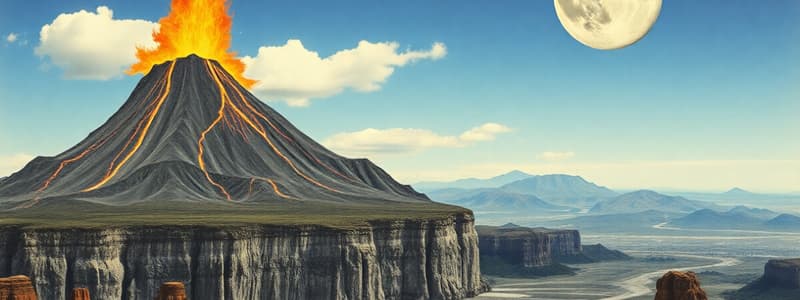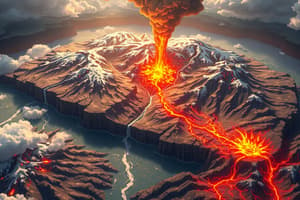Podcast
Questions and Answers
What is the primary material ejected during the formation of cinder cone volcanoes?
What is the primary material ejected during the formation of cinder cone volcanoes?
- Lava flows
- Tephra (correct)
- Magma
- Ash
Which type of volcano is primarily characterized by alternating layers of ash and hardened lava?
Which type of volcano is primarily characterized by alternating layers of ash and hardened lava?
- Cinder cone volcano
- Composite volcano (correct)
- Shield volcano
- Lava dome
What is the relationship between pressure and temperature in the Earth's crust and mantle?
What is the relationship between pressure and temperature in the Earth's crust and mantle?
- Pressure decreases with depth while temperature increases
- Both pressure and temperature decrease with depth
- Pressure increases with depth while temperature decreases
- Pressure and temperature both increase with depth (correct)
Which type of magma is associated with the most explosive eruptions?
Which type of magma is associated with the most explosive eruptions?
What defines the explosivity of a volcano?
What defines the explosivity of a volcano?
What type of eruptions are typically associated with oceanic-continental subduction volcanoes?
What type of eruptions are typically associated with oceanic-continental subduction volcanoes?
What is a common characteristic of eruptions at divergent boundaries?
What is a common characteristic of eruptions at divergent boundaries?
Which structure is responsible for storing magma beneath the Earth's surface?
Which structure is responsible for storing magma beneath the Earth's surface?
Which type of volcano is characterized by broad, gently sloping sides and results from nonexplosive eruptions?
Which type of volcano is characterized by broad, gently sloping sides and results from nonexplosive eruptions?
What occurs when magma emerges from a volcanic vent?
What occurs when magma emerges from a volcanic vent?
What distinguishes the formation of chains of volcanoes over stationary hotspots?
What distinguishes the formation of chains of volcanoes over stationary hotspots?
What is a caldera?
What is a caldera?
What is formed when lava flows out of long cracks in the Earth's crust?
What is formed when lava flows out of long cracks in the Earth's crust?
Flashcards
Divergent Plate Boundary
Divergent Plate Boundary
A zone where Earth's tectonic plates move apart, allowing magma to rise and erupt.
Hotspot
Hotspot
An area of volcanic activity caused by a plume of hot mantle material rising towards the Earth's surface.
Caldera
Caldera
A large, bowl-shaped depression at the summit of a volcano, often formed by a major eruption.
Vent
Vent
Signup and view all the flashcards
Shield Volcano
Shield Volcano
Signup and view all the flashcards
Cinder Cone
Cinder Cone
Signup and view all the flashcards
Composite Volcano
Composite Volcano
Signup and view all the flashcards
Magma
Magma
Signup and view all the flashcards
Cinder Cone Volcano
Cinder Cone Volcano
Signup and view all the flashcards
Basaltic Magma
Basaltic Magma
Signup and view all the flashcards
Rhyolitic Magma
Rhyolitic Magma
Signup and view all the flashcards
Study Notes
Zones of Volcanism
- Volcanism occurs at convergent plate boundaries, divergent plate boundaries, and hot spots.
- Oceanic-continental subduction zones cause mantle melting and magma rising, forming volcanoes. Most land volcanoes result from this type of subduction, known as explosive eruptions.
- Divergent boundaries typically produce nonexplosive eruptions. Pillow lava is formed at divergent boundaries on the ocean floor.
- Hot spots are unusually hot areas in Earth's mantle. High-temperature plumes of mantle material rise to the surface in these locations.
Hotspots and Plate Motion
- Chains of volcanoes over stationary hotspots show plate motion.
- Flood basalts are formed when lava flows out of long cracks in Earth's crust, called fissures.
Anatomy of a Volcano
- Crater: A bowl-shaped depression at the volcano's summit surrounding the vent.
- Caldera: Larger depressions at the summit of a volcano.
- Magma Chamber: A region below Earth's surface that stores molten material known as magma.
- Vent: The opening where lava emerges.
- Conduit: A tube-like structure that transports magma from the magma chamber to the vent.
Types of Volcanoes
- The appearance of a volcano depends on the materials that form the volcano and the eruptions.
- Volcanoes are classified as shield volcanoes, cinder cones, and composite volcanoes.
Shield Volcanoes
- Shield volcanoes have broad, gently sloping sides and a nearly circular base.
- They form from layers of lava accumulated during nonexplosive eruptions.
- Shield volcanoes are the largest type of volcano.
Cinder Cone Volcanoes
- Cinder cones have steep sides and are the smallest type of volcano.
- These volcanoes are formed when eruptions eject small pieces of lava into the air, forming tephra.
- Tephra falls back to Earth and piles up around the vent.
Composite Volcanoes
- Composite volcanoes are formed from layers of ash and hardened lava chunks from violent eruptions, alternating with layers of lava.
- These volcanoes form cone-shaped structures with concave slopes before solidifying.
Eruptions
- A volcano erupts when pressure from the magma forces its way to the surface.
Making Magma
- Pressure increases with depth due to overlying rock weight.
- As pressure increases, temperature also increases.
- This explains why most rocks in Earth's lower crust and upper mantle are solid, while those in the core are liquid.
Types of Magma
- Volcano explosivity depends on magma composition.
- Basaltic: Forms when upper mantle rock melts. Associated with quiet eruptions.
- Andesitic: Found along oceanic-continental subduction zones. Intermediate explosivity.
- Rhyolitic: Results when molten material mixes with the overlying continental crust. Extremely explosive.
Studying That Suits You
Use AI to generate personalized quizzes and flashcards to suit your learning preferences.



